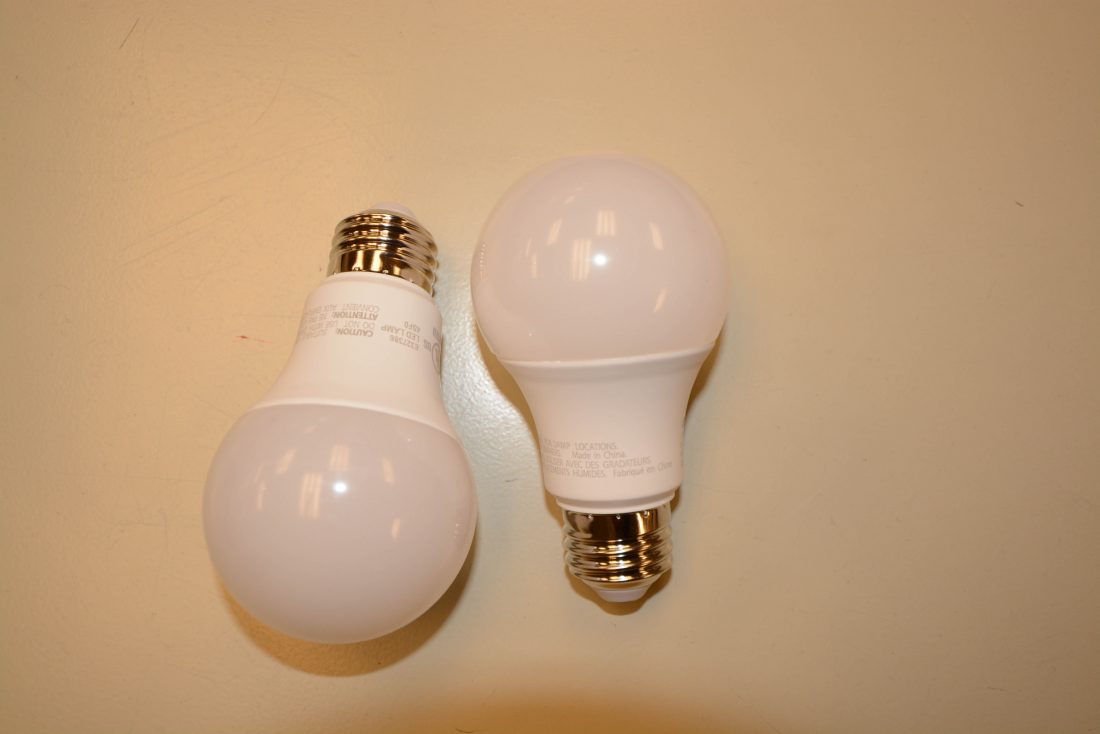Energy conservation and efficiency equals savings

LED lights are long-lasting and efficient. (Enterprise photo — Lou Reuter)
When I ask people what they think are the two cheapest, cleanest, safest, most environmentally friendly and most reliable energy technologies available today, the answer I receive is almost always wind and solar. But the correct answers — conservation and efficiency — have nothing to do with generating electricity. And the first step to utilizing these technologies is to commit, individually and collectively, to making a coherent and lasting reduction in our consumption of energy.
Energy conservation
The term ‘energy conservation’ implies using less or cutting back on use; in other words, avoiding excessive use or waste. Its basic principle has to do with applying simple behavioral changes to our lives; turning down thermostats for example, especially when we’re not at home or while we’re sleeping; turning off and/or unplugging appliances when they’re not in use; or driving your car a few less miles every week. These simple practices can conserve substantial amounts of energy and save considerable amounts of money. However, in all of these examples, the amount of energy used is reduced by either cutting down on your comfort level or doing without or with less.
Energy efficiency
Unlike conservation, efficiency is science- or technology-based and implies achieving equivalent or superior results while using less energy or using energy more effectively. Insulating a building, for example, or even just plugging up the leaks that allow cold air to slip into your house, will allow you to achieve and maintain comparable or even greater comfort, while using less heating energy.
Energy efficient lighting — LEDs vs. incandescents vs. CFLs
LED (light-emitting diode) lighting is just one example of technology-based energy efficiency. Lighting typically accounts for about 20% of home electricity consumption and LEDs are the most efficient lighting option on the market. For many people however, the cost of the bulb is the deciding factor when buying replacements. And, since incandescents are the cheapest bulbs on the market, they buy incandescents. Regrettably, this thinking fails to consider the cost of operation, or return on investment.
The average incandescent bulb will last around 1,200 hours before burning out. EnergyStar rated LEDs can last 50,000 hours or more. This means that you’ll have to purchase at least 40 incandescent lightbulbs just to equal the lifespan of a single LED. (It also means that the string of LED Christmas lights you have on your tree today will still be working 40 years from now.) What’s more, a 60-watt incandescent light bulb will consume 60 watts of energy, while an equivalent 800-lumen LED will only consume about 8.5 watts, or roughly 14% of the energy of the incandescent. That’s an 86% energy savings. Combine that with the savings on bulb repurchasing over time and it can add up to… well… a lot of saved money.
Compact fluorescent lightbulbs (CFLs) produce light differently than incandescent bulbs. In incandescent bulbs, electric current runs through a wire filament and heats the filament until it starts to glow. In a CFL, an electric current is driven through a tube containing argon and a small amount of mercury vapor. This generates invisible ultraviolet light that excites a fluorescent coating (called phosphor) on the inside of the tube, which then emits visible light.
CFL bulbs have a projected lifespan of 8,000 – 10,000 hours; considerably more than the 1200-hour lifespan of incandescents, but just a fraction of the 50,000-hour lifespan of LEDs. 50,000 hours of CFL use will require 5 or 6 bulbs vs. one LED bulb. And, since an 8.5-watt LED will produce as much light as a 14-watt CFL (equivalent to a 60-watt incandescent), the LED bulb will use just 425 KWh (kilowatt hours) of electricity, as opposed to 700.
Not only do LED bulbs last almost forever, they’re durable. An LED bulb can drop to the floor without breaking. Incandescent bulbs and CFLs break easily when dropped. And small amounts of mercury can be released into the environment when a CFL breaks, or is improperly disposed of. Mercury can be poisonous and, as such, CFL bulbs cannot be recycled or disposed of in standard ways. They must be taken to a recycling center that deals with heavy metals to avoid environmental contamination. LEDs don’t contain mercury and are therefore less hazardous and easily thrown away.
Energy efficient appliances
Efficiency is the idea behind Energy Star rated appliances, as well. For example, Energy Star qualified clothes washers generally use about 30% less energy than standard models. And less than half the water that regular clothes washers use. And many Energy Star qualified clothes washers also have a greater capacity than conventional models. That means fewer loads are needed to wash comparable amounts of laundry.
More information
For more information about utility cost and use reduction and available energy assistance programs that will help you use less energy and improve the environment, contact your County Community Energy Advisor.
¯For Franklin and St. Lawrence Counties: Nick Hamilton-Honey; Cornell Cooperative Extension of St. Lawrence County nh327@cornell.edu or 315-379-9192 – ext. 230
¯For Clinton, Essex, and Hamilton Counties: Jen Perry; Adirondack North Country Association jperry@adirondack.org or 518-891-6200.



